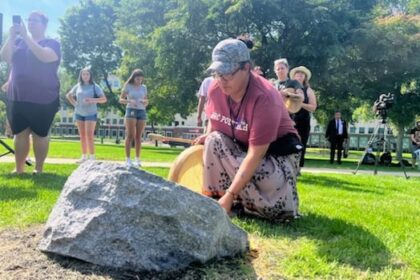ManitobaManitoba’s provincewide state of emergency is no longer in effect because of improving wildfire conditions, though the premier says risks remain for over a dozen communities that still aren’t clear of wildfire threats.’This is still a very serious situation,’ Premier Wab Kinew says Monday afternoonBryce Hoye · CBC News · Posted: Jun 23, 2025 1:04 PM EDT | Last Updated: 3 hours agoThere are still communities in danger that remain evacuated, officials say. (Mike Deal/The Canadian Press/Pool)A provincewide state of emergency is no longer in effect due to improving wildfire conditions, though risks remain for over a dozen communities that still aren’t clear of wildfire threats.Premier Wab Kinew announced the end to the Manitoba emergency order during a Monday news conference. It was originally issued May 28 amid a spate of wildfires that forced thousands to evacuate rural and northern communities.Kinew credited the end of the state of emergency to ongoing wildfire suppression efforts, favourable recent weather conditions and the “good nature and hard work” of Manitobans, particularly in the north and east, where people have been able to start returning home. “This is still a very serious situation,” Kinew said at the Manitoba Legislature.”We’re going to have to keep working together as thousands of our fellow Manitobans make their way home. We can do this with normal government powers, and it’s important that we have a light touch when it’s something as serious as declaring a state of emergency.”As of Sunday, 23 fires — seven of them considered out of control — were still burning across the province, said Kristin Hayward, assistant deputy minister of the Conservation Officer Service and the Manitoba Wildfire Service.There have been 129 wildfires so far this spring, she said, compared to the 20-year average of 118 by this time of year.Over 909,000 hectares of land have burned in the fires thus far, she said.Evacuees from some rural and remote regions have begun to return to their communities as the situation has improved around some of the fires.About 22,000 people were forced to evacuate their communities this spring. As of Monday, about 9,000 have been able to head home, said Christine Stevens, assistant deputy minister of the Manitoba Emergency Management Organization.All evacuees staying in Winnipeg had been moved into hotels as of early last week, after the initial crush of evacuees created a shortage of spaces.Winnipeg Mayor Scott Gillingham told CBC News late last week that two of four arenas and soccer complexes that have been devoted to helping and housing evacuees are in the process of being decommissioned as shelters, since they’re no longer needed. Recent rain and firefighting efforts have helped quell concerns in some parts of the province, but not all. Local states of emergency remain in place in 17 communities, and a dozen remain evacuated.Fires remain out of control near Lynn Lake, Jenpeg and Pimicikamak Cree Nation (Cross Lake), in the Bird River Nopiming Provincial Park area, in the Flin Flon and Sherridon area, and in the vicinity of Pukatawagan/Mathias Colomb First Nation.”Even though a number of folks have gone home, we still have a number of fires that are affecting communities, and all of these are still considered out of control,” Hayward said.Some evacuees permitted to return have been reporting seeing smoke and flames nearby, Hayward said.”Their communities are considered safe to occupy,” she said. “We do have staff on the ground that are responding to any potential or risk to the community.”Some of the 5,100 Flin Flon residents expecting to be allowed to head home this Wednesday are nervous about seeing the extent of damage to the northern community. A fire in the area was about 370,780 hectares in size as of the provincial fire bulletin released on Friday. Tataskweyak Cree Nation residents were given the green light to return about a week ago, only for chief and council of the northern community to reverse course hours later due to concerning levels of aluminum found in local water sources.Meanwhile, business owners, cottagers and residents in the south of Nopiming Provincial Park in eastern Manitoba got the go-ahead to return midweek last week. The Manitoba Lodges and Outfitters Association is calling on the province to provide owners with financial supports to help them shoulder losses due to a season cut short by the fires.Almost 300 firefighters from out of province — including from Newfoundland and Labrador, Parks Canada and U.S. federal and state agencies — were still in Manitoba as of last week to help with ongoing efforts.Find the latest wildfire information: Canadian wildfire map. Province of Manitoba fire bulletins. CBC’s wildfire tracker. Communities under evacuations in Manitoba. Are you an evacuee who needs assistance? Contact Manitoba 211 by calling 211 from anywhere in Manitoba or email 211mb@findhelp.ca.ABOUT THE AUTHORBryce Hoye is a multi-platform journalist with a background in wildlife biology. He has worked for CBC Manitoba for over a decade with stints producing at CBC’s Quirks & Quarks and Front Burner. He was a 2024-25 Knight Science Journalism Fellow at MIT. He is also Prairie rep for outCBC. He has won a national Radio Television Digital News Association award for a 2017 feature on the history of the fur trade, and a 2023 Prairie region award for an audio documentary about a Chinese-Canadian father passing down his love for hockey to the next generation of Asian Canadians.Email: bryce.hoye@cbc.caTwitterFacebookMore by Bryce Hoye
Monday, 22 Dec 2025
Canada – The Illusion
Search
Have an existing account?
Sign In
© 2022 Foxiz News Network. Ruby Design Company. All Rights Reserved.
You May also Like
- More News:
- history
- Standing Bear Network
- John Gonzalez
- ᐊᔭᐦᑊ ayahp — It happened
- Creation
- Beneath the Water
- Olympic gold medal
- Jim Thorpe
- type O blood
- the bringer of life
- Raven
- Wás’agi
- NoiseCat
- 'Sugarcane'
- The rivers still sing
- ᑲᓂᐸᐏᐟ ᒪᐢᑿ
- ᐅᑳᐤ okâw — We remember
- ᐊᓂᓈᐯᐃᐧᐣ aninâpêwin — Truth
- This is what it means to be human.
- Nokoma











